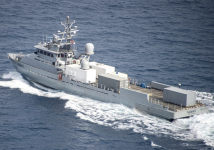I don't think much of the idea of the M10 as a "training tank." What you pretend to use as another thing in training will, most probably, end up being used that way in combat as well - and the M10 is not a tank. It does make conversion simpler for armoured crewman moving from an M10 unit to an M1 unit, but that's as far as I'd want to go.
As to Canada, IMHO we're not large enough for an M10 type of vehicle because more than anything else, we need tanks first. My greatest fear would be we buy an MPF for our "medium-weight" army and forget about tanks. While I have a lot of time for the Swedish CV line of vehicles I want a tank and IFV we can manufacture and sustain in Canada.

Maybe beating a dead horse here, but from the outside it seems like the M10 or something like it as a domestic training tank and deployable OOTW/COIN DFS vehicle can very much be part of a solution that greatly improves upon the status quo without radical reformation- and has the added bonus of returning to operational precedent.
Realistic outcomes of "exploring options to upgrade or replace our fleet of main battle tanks":
- The multi-decade shrink cycle continues, the 74 remaining Leo's are reduced to ~60, either replaced or upgraded to some semblance of a common variant
- The cycle is paused, all 74 remaining Leo's are upgraded
- All 74 + 8 replacements for those donated to Ukraine
The word "expand" or any allusion to it are distinctly missing, and going off of decades of procurement patterns- unlikely to be added at any point.
So... a fleet of 74-82 MBT's.
Through the SSE era that fleet provided for 1 deployable squadron with the tanks spread between schools, tech reference, and training equipment. 3:1 ratio between vehicles dedicated to capability generation and vehicles potentially tasked to capability employment.
Two generations previous, the 114 Leo C1's, 59 (2 squadrons manned, one flyover) tasked to NATO in Germany, slightly better than a 1:1 ratio.
Primary differences:
- Cold War defence policy called for a NATO tank regiment, whereas SSE only called for a squadron
- That era's RCAC had 265 Cougar "training tanks", and 114 MBT's
- The 114 were to a single standard of "combat grade" tanks, whereas only half of the SSE tanks were, with the other half lower quality "training tanks"
Which then strikes me:
- The CA MBT fleet from the SSE era was functionally only 40 tanks, not 82
- Said 40 tank fleet had a designed employment ratio of 1:1, just like the C1's of the Cold War
- We went from 265 "training tanks" to 42
So then- the solution where the M10 or something like it makes sense. By upgraded the entire remaining "tank" fleet to a theoretical Leopard 2AX CAN common, combat grade fleet, or replacing it with with new M1 (whether A2 or waiting for A3) you de facto expand the employable capability without expanding the "fleet"- using the same ~1:1 ratio it becomes possible to task 40 top of the line MBT's (2 squadrons, one rotationally manned, one flyover) in Latvia, with 34 back home to cover the Armour School, RCEME, tech ref, and work ups/ conversion training. Conversion training for what?
For the 6 squadrons (two per Regiment- the 3rd in LRSS) of tank crews that are kept current in armour TTP's, sub unit, and unit tactics in their full time assigned 30-40 tonne, 105-120mm armed, 3 man turret, tracked or 8x8 training tank/ DFS vehicle / Armoured Cavalry Vehicle. Is that best served by a Booker? A Centauro II? A bespoke vehicle born of a partnership between Rheinmettal and GDLS-C to marry a LAV 700 hull to a clone of the 2AX CAN turret? Adjust the slider between cost, delivery time, COIN/OOTW capability, logistical burden, and account for the commonality with whatever MBT is chosen.
Summary:
C1 era- 114 tank fleet, (59 tasked to NATO), training/OOTW fleet of 265 Cougars
SSE era - 40 tank fleet, (20 available for tasking), training fleet of 42 obsolescent Leo's
Cold War 2.0 Era - ??? Proposing 74-82 tank fleet, (40 tasked to NATO), training/OOTW fleet of ~140 suitable DFS vehicles







